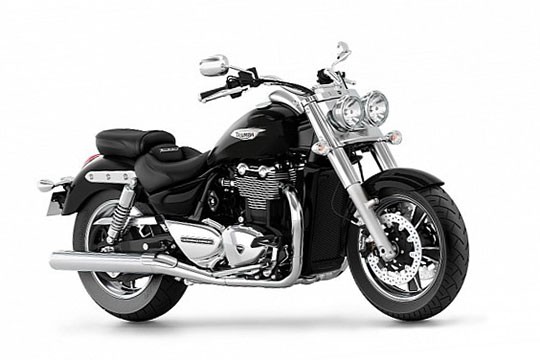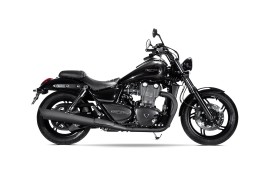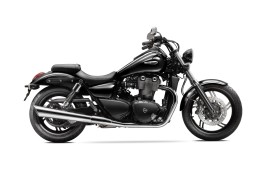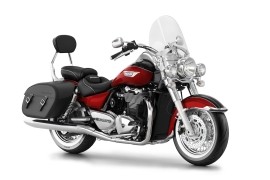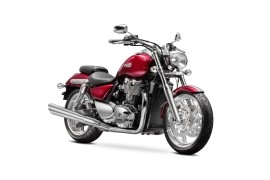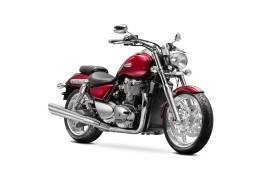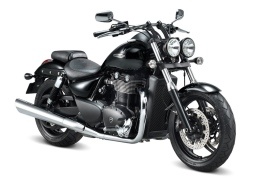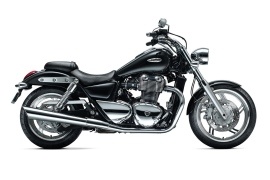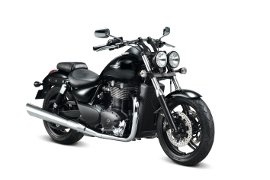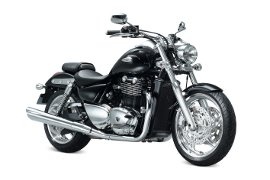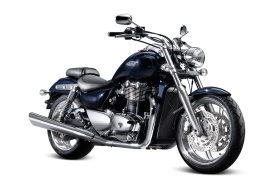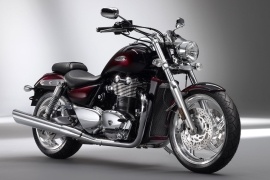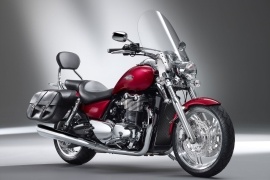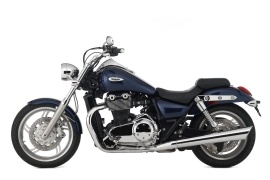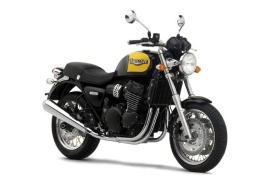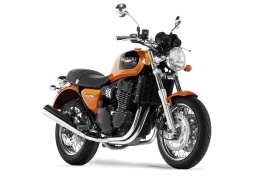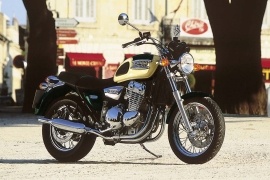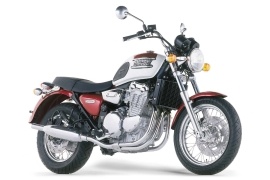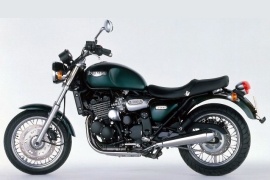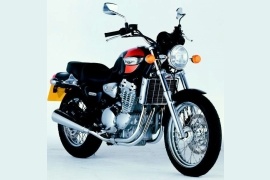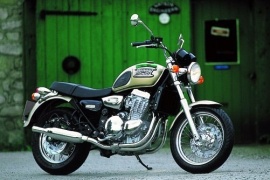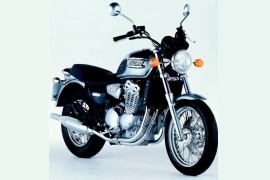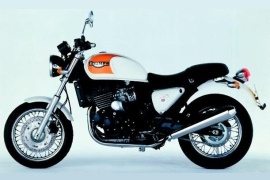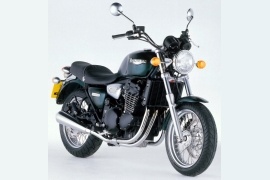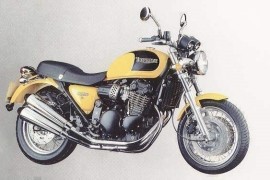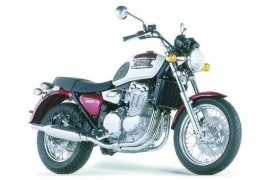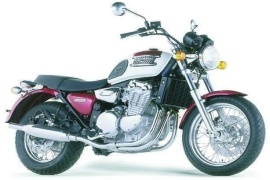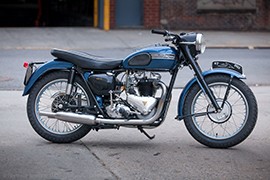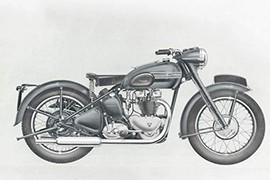TRIUMPH Thunderbird Models/Series Timeline, Specifications & Photos
First production year: 1950
In 2016, the British motorcycle manufacturer launched the Triumph Thunderbird Commander, a cruiser motorcycle powered by the largest-displacement twin-cylinder engine fitted on a production motorcycle.
Compared to the standard Thunderbird model, the Triumph Commander featured a dual round headlight system instead of a single round unit and different five-spoke lightweight aluminum wheels.
In the visual department, the Commander model had standard features, such as two smaller round headlights, a teardrop-shaped fuel tank with an integrated instrument panel, a two-piece dual seat, and a dual exhaust system with a muffler on each side.
Underneath its fuel tank, the 2016 Triumph Thunderbird Commander had installed a massive 1,699cc four-stroke two-cylinder liquid-cooled engine with a fuel injection system in charge, delivering an output power of 94 hp with maximum strength at 5,400 rpm and 146 Nm (108 lb-ft) torque at low 2,750 rpm.
In the suspension department, the bike packed a 47 mm Showa telescopic fork with 120 mm wheel travel on the front and two side-mounted Showa shock absorbers on the rear with five-position preload-adjustable and 95 mm wheel travel.
The bike's braking power was handled by two 310 mm floating discs coupled to four-piston Nissin calipers on the front wheel and a 310 mm disc tied to a dual-piston caliper on the rear wheel, offering excellent stopping power.
In 2015, the British motorcycle manufacturer launched the Triumph Thunderbird Nightstorm Special Edition, a cruiser motorcycle based on the standard Storm model but with a more aggressive look due to more blacked-out components.
Compared to the base Storm model, the special edition machine featured a custom paint job with ghost flames and a hand-painted tank logo, a blacked-out exhaust system covered with highly highly-resistant paint, a black-finished handlebar, mirrors, and a braking system with most components black.
In the aesthetic department, the bike had standard features, such as a twin round headlight system, a straight handlebar, a teardrop-shaped fuel tank with an integrated instrument panel, a two-piece dual seat, a dual exhaust system, and blacked-out five-spoke alloy wheels.
The bike was built around a tubular steel twin-spine frame with a 47 mm Showa telescopic fork on the front offering 120 mm wheel travel and two five-position preload-adjustable twin Showa shock absorbers on the rear with 95 mm wheel travel.
The bike's wheels were fitted with two 310 mm floating discs tied to four-piston Nissin calipers on the front and a 310 mm disc coupled to a dual-piston Brembo caliper on the rear, providing excellent stopping power.
As for the power figures, the 2015 Triumph Thunderbird Nightstorm Special Edition had its heartbeat set by a massive 1,699cc four-stroke parallel-twin liquid-cooled engine that delivered 98 hp at 5,200 rpm and 156 Nm (115 lb-ft) torque at 2,950 rpm.
The Triumph Thunderbird was a cruiser motorcycle that debuted in 2009 and was powered by a massive 1,597cc parallel-twin engine. The bike was designed by Tim Prentice in California and manufactured at the Hinckley factory in Leicestershire, England.
In 2014, the British motorcycle manufacturer launched the Triumph Thunderbird Storm, a cruiser motorcycle derived from the standard model with a larger engine due to an enhanced bore and a blacked-out appearance.
The 2014 Thunderbird Storm model had few differences from the base model, including the twin round headlight system instead of a single unit, a larger engine, and a blacked-out appearance that gave it a more aggressive look.
Most parts were painted black, such as the headlight housings, the fuel tank, fenders, wheels, and the engine. The only parts that shined on the Storm model were the fork sliders, the dual exhaust system, and engine cooling fins.
Mounted between the wheels, the 2014 Triumph Thunderbird Storm had a 1,699cc four-stroke two-cylinder liquid-cooled unit fed by a fuel injection system, boasting 98 hp at 5,200 rpm and 156 Nm (115 lb-ft) torque at 2,950 rpm.
The braking system was retained from the base model, with two 310 mm floating discs coupled to four-piston Nissin calipers on the front wheel and a 310 mm disc tied to a dual-piston Brembo caliper on the rear wheel.
The Triumph Thunderbird was a cruiser motorcycle with a large-displacement engine that debuted in 2009. The bike was manufactured at the Hinckley factory in Leicestershire, England, and designed by Tim Prentice in California.
In 2014, the British motorcycle manufacturer took the standard version of the machine and added lots of touring-oriented features that enhanced its cruising and touring capabilities, resulting in the 2015 Triumph Thunderbird LT.
The 2014 LT motorcycle received two additional lamps and a large windscreen on the front, a pulled-back handlebar, a restyled two-piece dual seat with a passenger backrest for more comfort, side-mounted and removable leather panniers, valanced fenders, and white wall tires mounted on wire-spoke wheels.
Besides that, the bike packed the same standard features, such as a round headlight, a teardrop-shaped fuel tank with an integrated instrument panel, a dual seat, a dual exhaust system with a muffler on each side, and side-mounted shock absorbers.
In the performance department, the 2014 Triumph Thunderbird LT packed a larger 1,699cc four-stroke two-cylinder liquid-cooled engine than the base model, fed by an electronically controlled fuel injection system, boasting 94 hp at 5,400 rpm and 146 Nm (108 lb-ft) torque at 2,750 rpm.
As for the braking power, the bike's wheels were fitted with two 310 mm floating discs tied to four-piston Nissin calipers on the front and a 310 mm disc with a dual-piston Brembo caliper on the rear.
In 2014, the British motorcycle manufacturer launched the Triumph Thunderbird, a cruiser motorcycle that debuted in 2009. The bike was manufactured at the Hinckley factory in Leicestershire, England.
Over its production years from 2009, the bike retained the same technical, aesthetic, and performance specifications without any significant modifications, except for color alterations and a tank-mounted instrument cluster.
In the visual department, the 2014 Thunderbird had fitted standard features, such as a round headlight, a teardrop-style fuel tank, a to-piece dual seat, side-mounted shock absorbers on the rear, a dual exhaust system with a silencer on each side, and five-spoke alloy wheels.
The bike's suspension system was retained from previous models, with a 47 mm Showa Telescopic fork on the front that offered 120 mm wheel travel and five-position adjustable twin shock absorbers on the rear with 95 mm wheel travel.
The braking power was handled by two 310 mm floating discs coupled to four-piston Nissin calipers on the front wheel and a 310 mm disc with a dual-piston Brembo caliper on the rear wheel, offering excellent stopping power.
As for the power figures, the 2014 Triumph Thunderbird had installed between the wheels a 1,597cc four-stroke two-cylinder liquid-cooled engine fed by a fuel injection system, boasting 86 hp with maximum strength at 4,850 rpm and 146 Nm (108 lb-ft) torque at 2,750 rpm.
The Triumph Thunderbird was a large-displacement cruiser motorcycle that debuted in 2009, manufactured by Triumph at the Hinckley factory in Leicestershire, England. The bike was designed by Tim Prentice in California and packed a large 17-inch 200 mm wide rear tire.
In 2013, the British motorcycle manufacturer launched the Triumph Thunderbird, a cruiser motorcycle that carried on the cruiser heritage of its predecessors. The bike was voted "Cruiser of the Year" by Cycle World magazine.
In the aesthetic department, the 2013 motorcycle had fitted standard features, such as a round headlight, a teardrop-style fuel tank with an integrated instrument cluster, a two-piece dual seat, a dual exhaust system with a silencer on each side, and five-spoke lightweight aluminum wheels.
In the performance department, the 2013 Triumph Thunderbird had installed between the wheels a 1,597cc four-stroke parallel-twin liquid-cooled engine managed by an electronically controlled fuel injection system, boasting 86 hp at 4,850 rpm and 146 Nm (108 lb-ft) torque at 2,750 rpm.
The Thunderbird was built around a tubular steel twin-spine frame with a 47 mm Showa telescopic fork on the front and tin five-position adjustable Showa shock absorbers on the rear, delivering excellent suspension performance and handling.
As for the braking performance, the bike's wheels were fitted with two 310 mm floating discs coupled to four-piston Nissin calipers on the front and a 310 mm disc with a dual-piston Brembo caliper on the rear.
In 2012, the British motorcycle maker released the Triumph Thunderbird Storm, a cruiser motorcycle derived from the base Thunderbird. The Storm model debuted in 2011, featuring a larger engine and several design modifications.
The bike packed the same chassis as the standard model, twin round headlights instead of a single unit, a straight handlebar, and a blacked-out appearance that replaced all the chromed elements of the standard machine.
In the visual department, the Storm model had standard features, such as twin round headlights with black housings, a teardrop-shaped fuel tank, a two-piece dual seat, side-mounted rear shocks with black springs, a dual chromed exhaust system, and black-finished five-spoke aluminum wheels.
The bike's suspension system was retained from the base model, with a 47 mm Showa telescopic fork on the front that offered 120 mm wheel travel and twin five-position adjustable Showa shocks on the rear that provided 95 mm wheel travel.
The braking system was also retained, with two 310 mm floating discs tied to four-piston Nissin calipers on the front and a 310 mm disc with a dual-piston Brembo caliper on the rear, offering excellent stopping power.
As for the power figures, the 2012 Triumph Thunderbird Storm had its soul brought to life by a 1,699cc four-stroke parallel-twin liquid-cooled engine that delivered an output power of 98 hp at 5,200 rpm and 156 Nm (115 lb-ft) torque at 2,950 rpm.
The 2009 and later Triumph Thunderbird was a series of large-displacement cruiser motorcycles manufactured by Triumph at the Hinckley factory in Leicestershire, England. The bike was designed by Tim Prentice in California and featured a large 17-inch 200 mm wide rear tire.
In 2012, the British motorcycle manufacturer launched the Triumph Thunderbird, a cruiser motorcycle that packed the same technical, visual, and performance specifications as the previous model without any significant modifications.
In the aesthetic department, the 2012 machine had standard features, such as a round headlight on the front, a teardrop-shaped tank, a two-piece dual seat, side-mounted rear shocks, a dual exhaust system, and five-spoke lightweight aluminum wheels.
The bike was built on a tubular steel twin-spine frame with a 47mm Showa telescopic fork on the front, offering 120 mm wheel travel and five-position adjustable Showa shock absorbers on the rear with 95 mm wheel travel.
In the braking department, the bike's wheels were fitted with two 310 mm floating discs, four-piston Nissin calipers on the front, and a 310 mm disc with a dual-piston Brembo caliper on the rear. The safety was enhanced with an optional Anti-Lock Braking System (ABS).
As for the power figures, the 2012 Triumph Thunderbird had its heartbeat set by a 1,597cc four-stroke two-cylinder liquid-cooled engine fed by an electronically controlled fuel injection system, boasting 86 hp at 4,850 rpm and 146 Nm (108 lb-ft) torque at 2,750 rpm.
In 2011, alongside the standard model, the British motorcycle manufacturer launched the Triumph Thunderbird Storm, a cruiser machine powered by a larger engine with more power and torque, twin headlights, and a blacked-out appearance.
The 2011 Storm model featured twin headlights with black housings, a straight handlebar, a teardrop-shaped fuel tank, a two-piece dual seat, a chrome exhaust system, side-mounted shocks with black springs, black five-spoke wheels, and a black engine with polished cooling fins.
The bike was built on the same chassis as the standard model with a 47 mm Showa telescopic fork on the front with 120 mm wheel travel and twin five-position adjustable Showa shock absorbers on the rear, offering excellent handling.
The braking system was retained from the standard model, with two 310 mm floating discs tied to four-piston Nissin calipers on the front wheel and a 310 mm disc with a two-piston Brembo caliper on the rear wheel.
As for the power figures, the 2011 Triumph Thunderbird Storm had installed underneath its fuel tank a 1,699cc four-stroke parallel-twin liquid-cooled engine fed by an electronically controlled fuel injection system, delivering 97 hp with a peak force at 5,200 rpm and 156 Nm (115 lb-ft) torque at low 2,950 rpm.
The engine power was transferred to a six-speed manual transmission with a wet multi-plate clutch linked to the rear wheel through a final belt drive.
In 2011, the British motorcycle manufacturer introduced the Triumph Thunderbird, a motorcycle that represented their first entry in the premium cruiser sector, with classic design combined with ergonomics and performance engineering.
For 2011, the Thunderbird had a wide range of standard and limited edition special color schemes. Standard colors included the popular Phantom Black, two-tone Pacific Bluw with a Fusion White center stripe, and Aluminum Silver with a Phantom Black center stripe.
The special colors were represented by Phantom Red Haze and Phantom Blue Haze with hand-painted schemes that changed colors from nearly black to red and blue depending on how the sunlight reached them.
Also, a highly graphical color scheme based on the Cranberry Red was available for 2011, and two other versions of Crystal White and Sapphire Blue with bold Triumph graphics.
The 2011 machine had standard features, such as a round headlight, a teardrop-style fuel tank, a two-piece dual seat, side-mounted rear shocks, a dual exhaust system with a silencer on each side, and five-spoke lightweight aluminum wheels.
Underneath its fuel tank, the 2011 Triumph Thunderbird had installed a 1,597cc four-stroke parallel-twin liquid-cooled engine with a fuel injection system in charge, delivering 85 hp at 4,850 rpm and 146 Nm (108 lb-ft) torque at 2,750 rpm.
The power produced by the engine was handled by a six-speed manual transmission with a wet multi-plate clutch linked to the rear wheel through a final belt drive, pushing the motorcycle to 189 kph (117 mph).
In 2009, the British motorcycle manufacturer released a new series of Thunderbird models powered by a large displacement engine. The motorcycle was manufactured at the Hinckley factory in Leicestershire, England.
The bike's name came after a five-year hiatus from previous Triumph Thunderbird models, such as an 885cc powered machine and a 650cc twin Bonneville made in the mid-1960s. The latest but earlier model was the Thunderbird Sport model, dropped from production in 2004.
In 2010, the Triumph Company launched the Triumph Thunderbird, a cruising machine that featured the same package as the previous model, with the same technical, visual, and performance specifications, without any modifications.
In the visual department, the bike packed standard features, such as a round headlight, a teardrop-shaped fuel tank, a two-piece dual seat, a dual exhaust system, side-mounted shock absorbers, and five-spoke lightweight aluminum wheels.
The bike's suspension system comprised a 47 mm Showa telescopic fork on the front that offered 120 mm wheel travel and five-position adjustable Showa shock absorbers on the rear that offered 95 mm wheel travel.
As for the braking power, the bike relied on two 310 mm floating discs with four-piston Nissin Calipers on the front wheel and a 310 mm disc with a dual-piston Brembo caliper on the rear wheel.
In the performance department, the 2010 Triumph Thunderbird had its heartbeat set by a 1,599cc four-stroke two-cylinder liquid-cooled engine that delivered 85 hp at 4,850 rpm and 146 Nm (108 lb-ft) torque at 2,750 rpm.
In 2009, alongside the standard and SE models, the British motorcycle manufacturer launched the Triumph Thunderbird Big Bore, a cruiser motorcycle with a bored-out engine compared to the standard model.
The 2009 Big Bore, as its name says, received a larger bore with new pistons, liners, camshafts, and more powerful clutch springs to match the additional power and torque. In addition, the bike came with an exclusive Phantom Haze Red color scheme and optional accessories that made it stand out from the crowd even more.
In the aesthetic department, the 2009 Big Bore model has standard fittings, such as a round headlight on the front, a teardrop-shaped fuel tank, a two-piece dual seat, side-mounted shocks, a dual exhaust system with a muffler on each side, and five-spoke lightweight aluminum wheels.
The bike was built on a tubular steel twin-spine frame with a 47 mm Showa telescopic fork and 120 mm wheel travel on the front and dual side-mounted adjustable Showa shock absorbers with 95 mm wheel travel on the rear.
The bike's braking power was handled by two 310 mm floating discs with four-piston Nissin calipers on the front and a 310 mm disc with a dual-piston Brembo caliper on the rear, offering excellent stopping power.
As for the power figures, the 2009 Triumph Thunderbird Big Bore had its soul brought to life by a 1,700cc four-stroke parallel-twin liquid-cooled engine that delivered 97 hp at 4,850 rpm and 156 Nm (115 lb-ft) torque at 2,750 rpm.
In 2009, the British motorcycle manufacturer launched the Triumph Thunderbird, a large displacement cruiser motorcycle made at the Hinckley factory in Leicestershire, England. The cruiser motorcycle featured a large 17-inch 200 mm wide rear wheel and was designed by Tim Prentice in California.
In 2009, in addition to the standard model, the maker released The Triumph Thunderbird SE, essentially a base version with extra touring-oriented accessories that enhanced its overall touring capabilities.
The 2009 Thunderbird SE had a detachable large windscreen for better wind protection, a passenger backrest for more comfort, a luggage rack with side-mounted leather panniers for extra storage, a more comfortable seat, and floorboards for both rider and passenger.
Besides that, the bike packed standard features, such as a large round headlight, a one-piece dual seat, a teardrop fuel tank, chromed engine covers, a dual exhaust system with a silencer on each side, a side stand, and five-spoke lightweight aluminum wheels.
The bike was built on a tubular steel twin-spine frame, packing a 47 mm Showa telescopic fork on the front with 120 mm wheel travel and five-position adjustable twin Showa shocks on the rear with 95 mm wheel travel.
In the performance department, the 2009 Triumph Thunderbird SE had its soul brought to life by a 1,599cc four-stroke parallel-twin liquid-cooled engine fed by an electronically controlled fuel injection system, boasting 85 hp at 4,850 rpm and 146 Nm (108 lb-ft) torque at 2,750 rpm.
In 2009, the British motorcycle manufacturer introduced a new series of Thunderbird models with a large displacement engine. The motorcycle was manufactured at the Hinckley factory in Leicestershire, England.
The bike's name came after a five-year hiatus from previous Triumph Thunderbird models, such as an 885cc powered machine and a 650cc twin Bonneville made in the mid-1960s. The latest but earlier model was the Thunderbird Sport model, dropped from production in 2004.
Compared to the earlier model, the new Thunderbird had a more relaxed riding position and packed standard fittings, such as a round headlight, a teardrop-shaped fuel tank, a two-piece dual seat, side-mounted shock absorbers, a dual exhaust system with a muffler on each side, and five-spoke lightweight aluminum wheels.
The bike's suspension system comprised a 47 mm Showa telescopic fork on the front with 120 mm wheel travel and twin adjustable Showa shock absorbers on the rear with 95 mm wheel travel, offering excellent handling.
In the braking department, the bike's wheels were fitted with two 310 mm floating discs coupled to four-piston Nissin calipers on the front and a 310 mm disc with a dual-piston Brembo caliper on the rear.
As for the power figures, the 2009 Triumph Thunderbird had mounted between the wheels a 1,599cc four-stroke liquid-cooled parallel-twin engine with a fuel injection system in charge, delivering 85 hp at 4,850 rpm and 146 Nm (108 lb-ft) torque at 2,750 rpm.
In 2003, the British motorcycle manufacturer launched the Triumph Thunderbird Sport, a motorcycle designed for riders looking for a classic-looking machine with modern technology and performance.
In the aesthetic department, the 2003 model was fitted with standard features, such as a large round headlight on the front, a one-piece dual seat, a dual exhaust system, a black-finished engine, and lightweight wire-spoke wheels with chromed rims.
In addition, the bike was available with Genuine Triumph Accessories, including an alarm, different silencers only for off-road use, a tank bag, other windscreens, a color-matched fly screen, a grab rail, a sissy bar, a luggage rack, a front fender extension, and many chromed elements.
Underneath its fuel tank, the 2003 Triumph Thunderbird Sport had installed an 885cc four-stroke three-cylinder liquid-cooled engine fed by three carburetors, delivering an output power of 83 hp at 8,000 rpm and 71 Nm (52 lb-ft) torque at 4,000 rpm.
In the suspension department, the motorcycle packed a 43 mm fully adjustable telescopic fork on the front and an adjustable shock absorber on the rear, delivering excellent handling capabilities.
As for the braking power, the bike's wheels were fitted with two 320 mm discs coupled to dual-piston calipers on the front and a 285 mm disc tied to a two-piston caliper on the rear, offering excellent stopping power.
In late 1994, the Triumph company based at Hinckley in Leicestershire, England, introduced the Triumph Thunderbird 900. The bike played a significant role in Triumph's successful re-entry into the United States market.
The manufacturer released several Thunderbird versions, including the standard Thunderbird, Triumph Legend, Triumph Adventurer, and Triumph Sport models. The base model was produced until 2003, and the Sport model made it until 2004.
In 2002, the British motorcycle manufacturer launched the Triumph Thunderbird Sport, a motorcycle designed for riders looking for a classic-looking machine with modern performance.
In the visual department, the 2002 Sport version had standard features, such as a round headlight on the front with the instrument cluster mounted on top, a one-piece dual seat, a dual exhaust system, a black-finished engine, and wire-spoke wheels.
The bike’s suspension system comprised a 43 mm fully adjustable telescopic fork on the front and an adjustable shock absorber on the rear, delivering optimum suspension performance and handling capabilities.
As for the braking power, the bike relied on two 320 mm discs with dual-piston calipers on the front wheel and a 285 mm disc with a two-piston caliper on the rear wheel, offering excellent stopping power.
In the performance department, the 2002 Triumph Thunderbird Sport had its soul brought to life by an 885cc four-stroke liquid-cooled three-cylinder engine that delivered 83 hp at 8,500 rpm and 76 Nm (56 lb-ft) torque at 6,500 rpm.
In 1994, the British motorcycle manufacturer introduced the Triumph Thunderbird 900, coded as the T309RT. The bike was manufactured at the Hinckley factory in Leicestershire, England, and played an essential role in the re-entry of Triumph in the United States market.
Alongside the standard model, the motorcycle maker introduced three other versions. The Triumph Thunderbird Legend, Thunderbird Adventurer, and Thunderbird Sport. The base model was manufactured until 2003, and the Sport model until 2004.
In 2002, the British motorcycle manufacturer introduced the Triumph Thunderbird, a machine that packed the same technical, visual, and performance specifications as previous models without any significant modifications, except for color changes.
The 2002 motorcycle was available in a new Sunset Red with Opal and Graphite with Jet Black infill. It packed standard features, such as a round headlight on the front, a one-piece dual seat, a dual exhaust system with a silencer on each side, and wire-spoke wheels.
Underneath its fuel tank, the 2002 Triumph Thunderbird had installed an 885cc four-stroke three-cylinder liquid-cooled engine, boasting 70 hp with a peak force at 8,000 rpm and 71 Nm (52 lb-ft) torque at 4,000 rpm.
The power produced by the engine was transferred to a six-speed manual transmission with a wet multi-plate clutch linked to the rear wheel through an X-ring final chain drive, pushing the motorcycle to 191 kph (119 mph).
The Triumph Thunderbird 900 was a naked motorcycle with a classic style and a modern engine and chassis introduced by Triumph in 1994. The bike was manufactured at the Hinckley factory in Leicestershire, England.
In addition to the standard model, the British motorcycle maker introduced three other versions. The Triumph Thunderbird Legend, Thunderbird Adventurer, and Thunderbird Sport. The Base model was manufactured until 2003, while the Sport model until 2004.
In 2001, the British motorcycle manufacturer launched the Triumph Thunderbird, a naked machine with classic styling backed by modern technology, designed to deliver a retro appearance.
In the visual department, the 2001 motorcycle featured the same standard fittings as previous models, including a large round headlight with instruments mounted on top, a one-piece dual seat, a dual exhaust system with a silencer on each side, and wire-spoke wheels.
The bike was built on a micro-alloyed high tensile steel spine frame with a 43 mm telescopic fork, a 320 mm brake disc with a dual-piston caliper on the front, and an adjustable shock absorber with a 285 mm brake disc with a tow-piston caliper on the rear.
Underneath its fuel tank, the 2001 Triumph Thunderbird had installed an 885cc four-stroke three-cylinder liquid-cooled engine that delivered an output power of 70 hp at 8,000 rpm and 71 Nm (52 lb-ft) torque at 4,000 rpm.
The Triumph Thunderbird 900 was a naked motorcycle manufactured by Triumph at the Hinckley factory in Leicestershire, England. The 1994 motorcycle played a vital role in Triumph's successful re-entry into the United States market.
Alongside the base model, the motorcycle manufacturer introduced three other variations. The Triumph Thunderbird Legend, Thunderbird Adventurer, and Thunderbird Sport. The base model continued production until 2003, and the Sport model until 2004.
In 2000, the British motorcycle manufacturer launched the Triumph Thunderbird Legend TT, essentially a budget version of the Thunderbird sharing the same engine with the base model. The Legend version was designed for riders looking for a classic-styled machine with lively performance and everyday versatility.
The bike was built on a micro-alloyed high tensile steel spine frame with a 43 mm telescopic fork on the front and an adjustable shock absorber on the rear, offering optimum suspension performance and handling.
The braking power was handled by a 320 mm disc tied to a dual-piston caliper on the front wheel and a 285 mm disc coupled to a two-piston caliper on the rear wheel, offering optimum stopping power.
In the performance department, the 2000 Triumph Thunderbird Legend had installed underneath its fuel tank an 885cc four-stroke three-cylinder liquid-cooled engine that delivered an output power of 69 hp at 8,000 rpm and 69 Nm (51 lb-ft) torque at 4,000 rpm.
In 2000, the British motorcycle manufacturer released the Triumph Thunderbird Adventurer, a motorcycle slightly modified compared to the base model to handle urban traffic and rougher terrains, offering more comfort.
It packed the same engine, frame, front fork, rear shock, and brakes as the Thunderbird 900 but with a raised handlebar and a single seat. The large rear fender, chrome-plated cam and radiator covers, and megaphone-shaped silencers represented the most notable features.
In other departments, the bike was identical to the base model, packing standard features, such as a round headlight with an instrument panel mounted on top, a single seat, a dual exhaust system, and lightweight wire-spoke wheels with chromed rims.
The bike was built on a micro-alloyed high tensile steel frame with a 43 mm telescopic fork on the front and an adjustable shock absorber on the rear, offering optimum suspension performance and handling.
The braking power was handled by a 320 mm disc with a two-piston caliper on the front wheel and a 285 mm disc with a dual-piston caliper on the rear wheel, offering optimum braking performance.
As for the power figures, the 2000 Triumph Thunderbird Adventurer had its heartbeat set by an 885cc four-stroke liquid-cooled three-cylinder engine that delivered an output power of 70 hp at 8,000 rpm and 69 Nm (51 lb-ft) torque at 4,000 rpm.
In 2000, the British motorcycle manufacturer launched the Triumph Thunderbird 900, a motorcycle that debuted in 1995 and carried on its heritage with an stylish blend of authentic retro styling and modern engine and chassis.
The 2000 Thunderbird featured the same package as the previous model without any modifications, delivering the same visual, technical, and performance specifications. The 2000 model was available in Cardinal Red with Chromium and Aston Green with Champagne.
The bike was fitted with standard features, such as a large round headlight with instruments mounted on top, a one-piece dual seat, a dual exhaust system with a silencer on each side, a side stand, and wire-spoke wheels.
Also, the machine was available with many Triumph Accessories, including an integrated alarm, different windscreens, a tank bag, a front mudguard extension kit, a leather pannier kit, a center stand, and many chromed elements.
The 2000 Triumph Thunderbird had its soul brought to life by an 885cc four-stroke three-cylinder liquid-cooled engine fed by three carburetors, delivering 70 hp with a peak force at 8,000 rpm and 71 Nm (52 lb-ft) torque at 4,000 rpm.
The bike's power was transferred to a six-speed manual transmission with a wet multi-plate clutch that spun the rear wheel through an X-ring final chain drive, pushing the motorcycle to 191 kph (119 mph).
From top speed to a complete stop, the motorcycle relied on a 320 mm disc with a dual-piston caliper on the front wheel and a 285 mm disc with a dual-piston caliper on the rear wheel.
In 1999, the British motorcycle manufacturer launched the Triumph Thunderbird, a naked motorcycle that debuted in 1994. The 1999 machine had the same package as previous models, without significant modifications.
In addition to the standard model, the British maker made available three more variations of the base model: the Triumph Thunderbird Sport, Thunderbird Legend, and Thunderbird Adventurer. The base model was manufactured until 2003, and the Sport model until 2004.
In the aesthetic department, the 1999 Thunderbird was fitted with standard features, such as a large round headlight with instruments mounted on top, a one-piece dual seat, a dual exhaust system with a muffler on each side, and wire-spoke wheels.
The bike was built around a micro-alloyed high tensile steel frame with a 43 mm fork on the front and an adjustable shock absorber on the rear, delivering optimum suspension performance and handling.
The braking performance was handled by a 320 mm disc tied to a dual-piston caliper on the front wheel and a 285 mm disc with a dual-piston caliper on the rear wheel, offering optimum stopping power.
In the performance department, the 1999 Triumph Thunderbird had its soul brought to life by an 885cc four-stroke three-cylinder liquid-cooled engine fed by three flat side carburetors, delivering 70 hp at 8,000 rpm and 71 Nm (52 lb-ft) torque at 4,000 rpm.
The Triumph Thunderbird was a motorcycle manufactured by Triumph From 1949 to 1966. The bike was made in many different forms, and its name was used three more times for new and distinct Triumph machines.
In late 1994, the Triumph company based at Hinckley in Leicestershire, England, introduced the Triumph Thunderbird 900. The bike was instrumental in Triumph's successful re-entry into the United States market.
The manufacturer released several Thunderbird models, including the standard Triumph Legend, Triumph Adventurer, and Triumph Sport. The base model was produced until 2003, and the Sport model made it until 2004.
In 1999, the British motorcycle manufacturer launched the Triumph Thunderbird Sport, a motorcycle created for riders looking for a classic machine with some extra modern grunt and road performance.
In the visual department, the 1999 Sport model had standard features, such as a round headlight with an instrument cluster mounted on top, a one-piece dual seat, a dual exhaust system with two silencers mounted on the right side, and wire-spoke wheels.
In the performance department, the 1999 Triumph Thunderbird Sport had installed underneath its fuel tank an 885cc four-stroke three-cylinder liquid-cooled engine managed by three carburetors, delivering 83 hp at 8,500 rpm and 76 Nm (56 lb-ft) torque with maximum strength at 6,500 rpm.
-In 1999, alongside the standard, Legend, and Sport models, the British motorcycle manufacturer launched the Triumph Thunderbird Adventurer, a motorcycle that blend the 50s and 60s appearance with the classic cruised design. The bike delivered plenty of street character and handled both city streets and highway roads.
The bike feature a low seating position and was perfect for shorter riders. It also offered excellent handling at both highway speeds or city heavy traffic. It also came with an optional restriction kit.
The visual department was similar to the other models, packing standard features, such as a round headlight, a one-piece dual seat, a dual exhaust system with a muffler on each side, and wire-spoke wheels.
The bike's suspension system comprised a 43 mm telescopic fork on the front and an adjustable shock absorber on the rear, delivering optimum suspension performance and handling.
As for the braking power, the bike's wheels were fitted with a 320 mm disc tied to a dual-piston caliper on the front and a 285 mm disc with a two-piston caliper on the rear, offering optimum stopping power.
In the performance department, the 1999 Triumph Thunderbird Adventurer had its soul brought to life by an 885cc four-stroke three-cylinder liquid-cooled engine that delivered 70 hp at 8,000 rpm and 69 Nm (51 lb-ft) torque at 4,000 rpm.
In 1999, the British motorcycle manufacturer launched the Triumph Legend TT, a motorcycle developed for riders looking for a classic-styled roadster with great performance and everyday versatility.
The bike was created for those searching for the street-worthiness of modern bikes combined with the retro attire of older sportsters. The Legend TT also brought exceptional low-speed maneuverability thanks to its low seat and ample handlebars.
In the visual department, the bike was fitted with standard features, such as a large round headlight with instruments mounted on top, a one-piece dual seat, a teardrop-shaped fuel tank, reversed-cone silencers, and wire-spoke wheels.
In addition, the bike was available with Genuine Triumph Accessories, such as an integrated alarm, a summer and roadster windscreen, a tank bag, a leather pannier kit, a grab rail, chromed elements, a center stand, and adjustable levers.
The bike's suspension system comprised a 43 mm telescopic fork on the front and an adjustable shock absorber on the rear, delivering optimum suspension performance and handling.
The braking power was handled by a 320 mm disc with a dual-piston caliper on the front wheel and a 285 mm disc with a two-piston caliper on the rear wheel, offering optimum stopping power.
As for the power figures, the 1999 Triumph Legend TT had its soul brought to life by an 885cc four-stroke three-cylinder liquid-cooled engine that delivered an output power of 70 hp at 8,000 rpm and 69 Nm (51 lb-ft) torque at 4,000 rpm.
In 1998, the British motorcycle manufacturer launched the Triumph Thunderbird Sport, a more sporty model than the standard version. In addition to the standard and Sport models, the maker made the Triumph T309TT Legend and the Triumph T309RC Adventurer available.
Compared to the base model, the Thunderbird Sport came with different wheels, an additional brake disc on the front, fully adjustable front and rear suspensions, and a boost to the engine from 62 to 82 hp.
Also, the aesthetic department was improved with a blacked-out engine instead of chrome, a redesigned exhaust system with two mufflers mounted on the right side, and the stitching and buttons were removed.
Besides that, the bike packed standard features, such as a round headlight with instruments mounted on top, a one-piece dual seat, a side stand, and lightweight wire-spoke wheels.
In the suspension department, the bike packed a 43 mm fully adjustable telescopic fork on the front and a fully adjustable shock absorber on the rear, delivering excellent suspension performance and handling.
The braking power was handled by two 320 mm discs with two-piston calipers on the front wheel and a 285 mm disc with a dual-piston caliper on the rear wheel.
As for the power figures, the 1998 Triumph Thunderbird Sport had installed an 885cc four-stroke three-cylinder liquid-cooled engine that delivered an output power of 82 hp at 8,000 rpm and 72 Nm (53 lb-ft) torque at 4,800 rpm.
In 1995, the British motorcycle manufacturer released the Triumph Thunderbird 900, a motorcycle manufactured at the Hinckley factory in Leicestershire, England. The bike was instrumental in Triumph's re-entry into the United States market.
The Triumph Thunderbird was a British motorcycle first introduced in 1949 and made in different shapes and forms until 1966. The name was also used for other distinct Triumph models.
The bike's name and retro styling harked back to the company's golden years of the 1960s. Also, it was the first classic machine manufactured by the recovering company. The bike's engine was made to look classic and modified for more torque at lower rpm.
Also, the British maker introduced other versions of the motorcycle, such as the Triumph T309TT Legend, Triumph T309RC Adventurer, and the Triumph T309RD Thunderbird Sport. The Thunderbird was manufactured until 2003, and the Sport version until 2004.
In the visual department, the motorcycle was fitted with standard features, such as a round headlight with instruments mounted on top, a one-piece dual seat, a dual exhaust system with a silencer on each side, and wire-spoke wheels.
The 1995 Triumph Thunderbird had installed underneath its fuel tank an 885cc four-stroke three-cylinder liquid-cooled engine that delivered an output power of 70 hp at 8,000 rpm and 72 Nm (53 lb-ft) torque at 4,800 rpm.
The Triumph Thunderbird was a British motorcycle first introduced in 1949 and manufactured in many shapes and forms until 1966. The name was used for other new and distinct Triumph models.
In 1995, the British motorcycle manufacturer introduced the Triumph Thunderbird 900, manufactured at the Hinckley factory in Leicestershire, England. The bike was instrumental in Triumph's re-entry into the United States market.
The bike featured a name and retro styling that harked back to the company's golden years of the 1960s. Also, it was the first classic machine manufactured by the resurgent company. The bike's engine was redesigned for a classic look and modified for more torque at lower rpm.
In addition, the maker introduced other versions of the bike, such as the Triumph T309TT Legend, Triumph T309RC Adventurer, and the Triumph T309RD Thunderbird Sport. The Thunderbird was manufactured until 2003, and the Sport version until 2004.
The 1995 model had standard features, such as a round headlight with instruments mounted on top, a one-piece dual seat, a dual exhaust system with a silencer on each side, and wire-spoke wheels.
In the performance department, the 1995 Triumph Thunderbird 900 had its soul brought to life by an 885cc four-stroke three-cylinder liquid-cooled engine that delivered an output power of 70 hp at 8,000 rpm and 72 Nm (53 lb-ft) torque at 4,800 rpm.
The Triumph Thunderbird 6T was a British motorcycle made from 1949 to 1966. It was also known as the TR65 and was intended to replace the Triumph Speed Twin. The Thunderbird name was used three more times for new and distinct Triumph models.
The bike was shown to the public at Montlhery, 26 km (16.2 miles) from Paris, where three standard bikes were ridden around a circuit with an average speed of 148 kph (92 mph) over a distance of 800 km (500 miles) and back to the Meriden factory.
In 1954, the British motorcycle manufacturer launched the Triumph Thunderbird, a motorcycle that featured several modifications, such as a new frame with a swingarm, replacing the rigid unit previously used, and a new look with a Shell Blue Sheen color scheme that retained the classic appearance.
The 1954 Triumph Thunderbird had installed a 649cc vertical twin OHC engine underneath its fuel tank that featured several internal changes, delivering an output power of 34 hw with a peak force at 6,500 rpm.
The bike's suspension system comprised a telescopic fork on the front with hydraulic damping and a swingarm with two Girling dampers, offering optimum suspension performance and handling.
In the braking department, the bike's wheels were fitted with front and rear SLS drum units, offering optimum stopping power.
The Triumph Thunderbird 6T was a British motorcycle manufactured from 1949 to 1966, also known as the TR65, and came as a replacement for the Triumph Speed Twin. The Thunderbird name was used three more times for new and distinct Triumph models.
The bike was shown to the public at Montlhery, 26 km (16.2 miles) from Paris, where three standard bikes were ridden around a circuit with an average speed of 148 kph (92 mph) over a distance of 800 km (500 miles) and back to the Meriden factory.
To succeed in the American market, the maker used for the Thunderbird 6T a version of the earlier Speed Twin engine with a larger bore from 500cc to 650cc to hand out more horsepower for American customers.
In the visual department, the bike was as simple as it gets, with a round headlight incorporated in a front cover, a single seat with springs underneath, a dual exhaust system, and lightweight wire-spoke wheels.
The bike was built on a brazed lug rigid frame with a telescopic fork on the front and a sprung rear hub for suspension and drum braking units both front and rear.
In the performance department, the 1950 Triumph Thunderbird 6T had its soul brought to life by a 649cc OHV air-cooled engine managed by a single carburetor, delivering an output power of 34 hp at 6,500 rpm.
